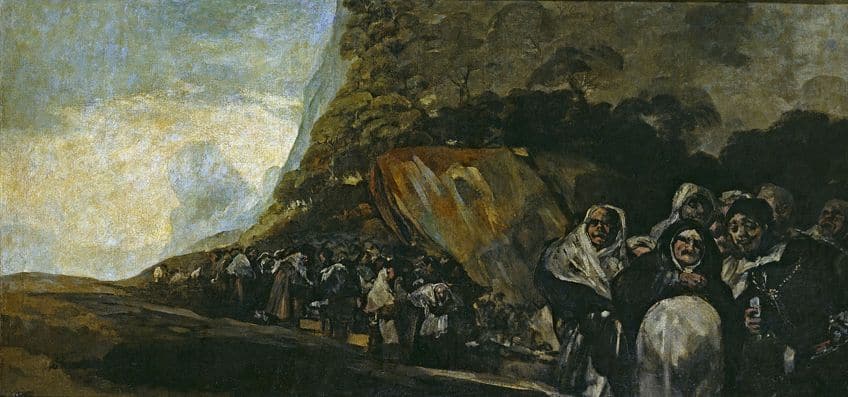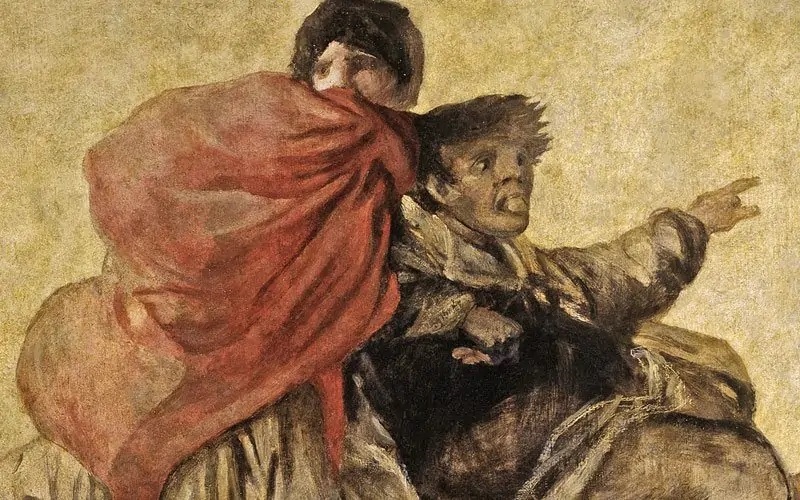Often considered the last of the Old Masters and the first of the Moderns, Francisco Goya (1746–1828) is one of the most influential artists in history. Goya is distinguished by his inventive use of technique and his capacity to convey the spirit of his subjects. He was skilled in various genres, including Rococo, Romanticism, and Realism. He frequently combined these aspects to produce his style. His audacious brushstrokes and dramatic use of shadow and light impacted Expressionists, Impressionists, and later artists.
Goya was an astute observer of his period, and his artwork frequently included scathing social and political criticism. His etchings, which include “Los Caprichos” and “The Disasters of War,” criticise human cruelty, the foolishness of war, and the corruption of the state and religion. These pieces are regarded as some of the first instances of art serving as a vehicle for social criticism. Goya is well known for his psychologically nuanced portraits that delve deeply into the inner lives of his subjects. His portrayal of the intricacies of human emotion and character was revolutionary. His well-known depictions of Spanish royalty, like “The Family of Charles IV,” highlight the weaknesses of human nature that lie beneath the exterior of grandeur and authority.
In particular, Goya pioneered the application of etching and aquatint in printmaking. Because of his skill with these media, he was able to create several pieces that were accessible to a larger audience. The classic printing pieces “Los Caprichos” and “The Disasters of War” highlight Goya’s skill at using various methods to communicate strong ideas. Later, Goya produced a group of eerie, black paintings called the “Black Paintings.” These were painted straight onto his home’s walls before being moved to canvas. The “Black Paintings” are renowned for their strong emotional impact and eerie motifs, representing Goya’s mental struggle and gloomy assessment of humanity. “Saturn Devouring, His Son” is still regarded as one of art history’s most essential and mysterious paintings.
The impact of Goya continues well into the present day. Many contemporary artists found resonance in their investigations of human suffering, political tyranny, and the darkest facets of the human condition. Goya’s paintings inspired painters like Édouard Manet, Pablo Picasso, and Francis Bacon. For instance, Picasso’s “Guernica” embodies the same kind of human anguish and political indignation as Goya’s “The Disasters of War.”
Francisco Goya Black Paintings

The “Black Paintings” by Francisco Goya are a group of 14 powerful and eerie pieces he produced in the latter years of his life, from 1819 to 1823. At first, he painted these murals straight onto the walls of his home, the Quinta del Sordo (Villa of the Deaf Man), which is located close to Madrid. They capture Goya’s depressing view of humanity and his rapidly declining mental health at this time.
The “Black Paintings” are distinguished by their dismal, dark colours and frequently unsettling content. With sporadic bursts of red and yellow, Goya’s limited colour scheme of black, brown, and grey helped to evoke a dreadful and oppressive mood. These pieces explore themes of terror, insanity, death, and the macabre, delving deeply into the human psyche. They portray the atrocities that Goya saw during his lifetime, such as political repression, war, and human misery, as well as his concerns. Unlike his previous commissioned pieces, the “Black Paintings” were made for Goya’s personal use, allowing him to convey his darkest ideas freely. The figures are depicted crudely and unrefinedly in the frequently disorganised compositions.
This painting, one of the most well-known “Black Paintings,” shows the fabled Titan Saturn swallowing one of his children to keep the others from taking over his position of authority. Saturn’s eyes are wildly open in this horrifying and insane image. The small, lonely puppy in this artwork appears overwhelmed by the enormous surrounding area as it looks upward. Despite its simplicity and ambiguity, the composition evokes a tremendous sense of helplessness and misery, making it one of the most emotional “Black Paintings.”
This painting shows a group of witches led by a goat-like demonic figure. The grotesque and inflated numbers emphasise the illogical superstitions and worries related to witchcraft in Goya’s day. This artwork shares a similar concept with “Witches’ Sabbath,” depicting a gloomy assembly where a gigantic goat figure rules over many unsettling, deformed women. The ominous and gloomy atmosphere perfectly captures the macabre fascination with the paranormal.
In this image from the Bible, Judith is seen holding a knife over Holofernes’s severed head. In contrast to conventional ones, Goya’s portrayal is harsh and stark, with an almost expressionistic use of colour and form. In this piece, two men who appear trapped in a dilemma fight violently with cudgels. One could interpret the artwork as a metaphor for how pointless and harmful human fighting is.
Artistic and Historical Significance
The “Black Paintings” stand out for their inventive approach and unadulterated emotional impact. Goya departs from the more refined style of his earlier works with expressive and aggressive brushwork. These works of art offer insight into Goya’s tormented thoughts in his later years. They are frequently seen as an expression of his anxieties, disappointments, and potentially his battles with mental illness. “Black Paintings” are the forerunners of contemporary art genres like Surrealism and Expressionism. Many following artists, such as Pablo Picasso and Edvard Munch, were affected by their psychological depth and investigation of gloomy topics.

Following Goya’s passing, the “Black Paintings” were recreated on canvases and are currently kept at Madrid’s Prado Museum. They continue to enthral and confound audiences with their potent imagery and great emotional depth, making them some of art history’s most mysterious and captivating pieces. Goya’s bold examination of the human condition in these works of art guarantees his status as a critical artist bridging art history’s classical and modern periods.
Goya went on to create some quite ominous artwork there. It seems that Goya never spoke about them; they were painted on the home’s walls. Goya painted for pleasure, contrasting his Black paintings with his earlier pieces. Although he never gave them names, art historians have given them insightful descriptions. These are referred to as Francisco Goya’s “Black Paintings” together. The proprietor of the mansion, Baron Frédéric Émile d’Erlanger, had these ominous images painted initially as murals on the walls. Still, he later “hacked” them off and put them on canvas. Francisco Goya painted straight on his dining and sitting room walls to create these ominous canvases with oil paints.
In the 19th century, most people did not recognise mental disease as an illness; instead, they saw it as lunacy or craziness. Mentally ill people were kept apart from society in asylums, also referred to as “madhouses.” The idea that isolation was a cure for lunacy gave rise to the modern asylum in Europe in the 18th and 19th centuries. Asylum populations, on average, kept rising, reaching over 1,000 patients at its peak in the middle of the century (Le Bonhomme). Mentally sick persons were frequently portrayed as monsters or other creatures in inhumane depictions of mental disease. In proper form, asylums were filthy, cramped, and dark places that the whole public could observe to witness the anarchy that existed there.
‘In 1793, Goya collapsed and suffered incapacitation and periods of illness and depression. These periods of illness led to a gradual loss of hearing until Goya was practically deaf. He faced anxiety about his hearing loss, which affected every aspect of his life. Once hearing loss became an issue in the classroom, Goya resigned from his teaching post at the Royal Academy. He sought multiple methods for curing his illness but eventually resigned from learning sign language. This loss heavily affected him to the point where he retired from public life in 1819 and spent the next five years in a country home near Madrid known as Quinta del Sordo, The House of the Deaf Man. Ironically, while he was entirely deaf at this time, the house was not named after him but after the previous owner, who was also a deaf man. This time spent in the country and at Quinta del Sordo marked a significant shift in Goya, and his inner darkness began to come to the surface through his works’, writes Katie Pittman.
Conclusion
Francisco Goya’s “Black Paintings” bears witness to the extremes of human emotion and his unwavering dedication to portraying the more sinister facets of life. These eerie creations, which Goya created in his later years, provide insight into his tormented psyche and capture the terrible times he lived through.
Specialising in themes of terror, insanity, mortality, and macabre, the “Black Paintings” are distinguished by their dark colour scheme, eerie imagery, and intense emotional content. Each painting captivates with its stark force and psychological depth, from the unsettling depiction of Saturn eating his son to the uncanny gatherings of witches and demonic entities.
8 Most Celebrated Paintings of Romantic-Political Master Francisco Goya





